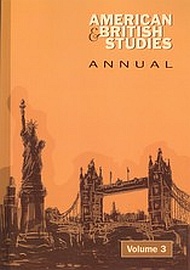Sherman Alexie’s Version and Subversion of Native American Storytelling Tradition
Keywords:
Native American literature; Sherman Alexie; storytelling; trickster; popular culture; subversionAbstract
Sherman Alexie understands writing as a means of fighting for the cultural identity of the American Natives against the dominant culture and also against the social compliance and lethargy of his own people. Since for him literature equals rage and imagination, the task of an artist is to be loud, poetic, cruel and inappropriate, in other words, to undermine mythologies. This assumption results in cruelly realistic work, for which reason Alexie is controversial. To non-native readers his voice is surprising and entertaining, but native readers often passionately disapprove of the images of natives Alexie depicts, as well as his distortion of the traditional narrative voice and its sacred function. What seems, however, to be the least traditional feature of Alexie’s work, an abundance of markers of popular culture, strikes me as a potent, though discomforting, challenge, inviting the reader, as good storytelling always does, to participate in the construction of meaning of our mutual present.
References
Alexie, Sherman. The Lone Ranger and Tonto Fistfight in Heaven. New York: Harper Perennial, 1994.
Alexie, Sherman. The Toughest Indian in the World. New York: Grove, 2000.
Alexie, Sherman. The Absolutely True Diary of a Half-Time Indian. New York: Hachette, 2007.
Alexie, Sherman. War Dances. New York: Grove, New York – Boston: Little, Brown and Co., 2009.
Atwood, Margaret. Trickster Makes This World: Mischief, Myth and Art by Lewis Hyde, L.A. Times, January 25, 1998, at http://www.owtoad.com/trickster.pdf, 15.08.2008.
Cook-Lynn, Elizabeth. “Who Stole Native American Studies?” Wicazo Sa Review, Vol. 12, No. 1 (Spring, 1997). University of Minnesota Press: 9-28. Accessed August 14, 2010. http://links.jstor.org/sici?sici=0749-6427%28199721%2912%3A1%3C9%3AWSNAS%3E2.0.CO%3B2-N.
Coulombe, Joseph L. “The Approximate Size of His Favorite Humor: Sherman Alexie’s Comic Connections and Disconnections in The Lone Ranger and Tonto Fistfight in Heaven.” American Indian Quarterly, Vol. 26, No. 1 (Winter, 2002). University of Nebraska Press: 94-115. Accessed August 28, 2009. http://www.jstor.org/stable/4128476.
Dix, Andrew. “Escape Stories: Narratives and Native Americans in Sherman Alexie’s The Lone Ranger and Tonto Fistfight in Heaven.” The Yearbook of English Studies, Vol. 31, North American Short Stories and Short Fictions (2001). Maney on behalf of Modern Humanities Research Association: 155-167. Accessed August 25, 2009. http://www.jstor.org/stable/3509382.
Frase, Joelle. “An Interview with Sherman Alexie.” The Iowa Review, Vol. 30, No. 3 (Winter, 2000/2001). University of Iowa: 59-70. Accessed August 27, 2009. http://www.jstor.org/stable/20154868.
McFarland, Ron. “Review of The Toughest Indian in the World by Sherman Alexie and Women on the Run.” Wicazo Sa Review. 16.2 (Autumn, 2001): 154-158. Rpt. in Short Story Criticism. Vol. 107. Detroit: Gale, 154-158. Accessed August 30, 2009. http://go.galegroup.com.ezproxy.lsua.edu/ps/start.do?-p=LitRC&u=lln_alsua.
Newton, John. “Sherman Alexie’s Autoethnography.” Contemporary Literature: American Poetry of the 1990s, Vol. 42, No. 2 (Summer, 2001). University of Wisconsin Press: 413-428. Accessed August 27, 2009. http://www.jstor.org/stable/1209128.
Lincoln, Kenneth. Indi’n Humor: Bicultural Play in Native America. Oxford-New York: Oxford University Press, 1993.
Lincoln, Kenneth. Sing with the Heart of a Bear: Fusion of Native and American Poetry (1890-1999). University of California Press, 2000.
Owens, Louis. Other Destinies. Norman-London: University of Oklahoma Press, 1992.
Owens, Louis. Mixedblood Messages. Norman: University of Oklahoma Press, 1998.
Penner, Jonathan. “Full Blooded.” Washington Post Book World, 2000, p. 7. Rpt. in Contemporary Literary Criticism Select. Detroit: Gale. Accessed August 30, 2009. http://go.galegroup.com.ezproxy.lsua.edups/-start.do?p=LitRC&u=lln_alsua.
Pulitano, Elvira. Toward a Native American Critical Theory. Lincoln – London: Univerrsity of Nebraska Press, 2003.
Smith, Jeanne Rosier. Writing Tricksters: Mythic Gambols in American Ethnic Literature. Barkley-Los Angeles-Oxford: University of California Press, 1997.
Vizenor, Gerald. Manifest Manners in Postindian Survivance. Lincoln-London: University of Nebraska Press, 1999.
Watson, Garry. Opening Doors: Thought From (and of) the Outside. Aurora: Davies, 2008.
Womack, Craig S, Daniel Heath Justice, Christopher B. Teuton. Reasoning Together: The Native Critics Collective. Norman: University of Oklahoma Press, 2008.
Wyrick, Katherine H. “Crossing Cultures: Sherman Alexie Explores the Sacred and the Profane.” Accessed August 14, 2008. http://www.bookpage.com/0306bp/sherman_alexie.html.


